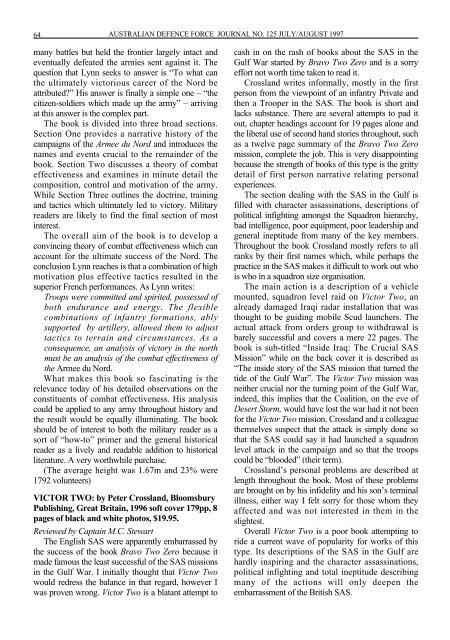ISSUE 125 : Jul/Aug - 1997 - Australian Defence Force Journal
ISSUE 125 : Jul/Aug - 1997 - Australian Defence Force Journal
ISSUE 125 : Jul/Aug - 1997 - Australian Defence Force Journal
Create successful ePaper yourself
Turn your PDF publications into a flip-book with our unique Google optimized e-Paper software.
64AUSTRALIAN DEFENCE FORCE JOURNAL NO. <strong>125</strong> JULY/AUGUST <strong>1997</strong>many battles but held the frontier largely intact andeventually defeated the armies sent against it. Thequestion that Lynn seeks to answer is “To what canthe ultimately victorious career of the Nord beattributed?” His answer is finally a simple one – “thecitizen-soldiers which made up the army” – arrivingat this answer is the complex part.The book is divided into three broad sections.Section One provides a narrative history of thecampaigns of the Armee du Nord and introduces thenames and events crucial to the remainder of thebook. Section Two discusses a theory of combateffectiveness and examines in minute detail thecomposition, control and motivation of the army.While Section Three outlines the doctrine, trainingand tactics which ultimately led to victory. Militaryreaders are likely to find the final section of mostinterest.The overall aim of the book is to develop aconvincing theory of combat effectiveness which canaccount for the ultimate success of the Nord. Theconclusion Lynn reaches is that a combination of highmotivation plus effective tactics resulted in thesuperior French performances. As Lynn writes:Troops were committed and spirited, possessed ofboth endurance and energy. The flexiblecombinations of infantry formations, ablysupported by artillery, allowed them to adjusttactics to terrain and circumstances. As aconsequence, an analysis of victory in the northmust be an analysis of the combat effectiveness ofthe Armee du Nord.What makes this book so fascinating is therelevance today of his detailed observations on theconstituents of combat effectiveness. His analysiscould be applied to any army throughout history andthe result would be equally illuminating. The bookshould be of interest to both the military reader as asort of “how-to” primer and the general historicalreader as a lively and readable addition to historicalliterature. A very worthwhile purchase.(The average height was 1.67m and 23% were1792 volunteers)VICTOR TWO: by Peter Crossland, BloomsburyPublishing, Great Britain, 1996 soft cover 179pp, 8pages of black and white photos, $19.95.Reviewed by Captain M.C. StewartThe English SAS were apparently embarrassed bythe success of the book Bravo Two Zero because itmade famous the least successful of the SAS missionsin the Gulf War. I initially thought that Victor Twowould redress the balance in that regard, however Iwas proven wrong. Victor Two is a blatant attempt tocash in on the rash of books about the SAS in theGulf War started by Bravo Two Zero and is a sorryeffort not worth time taken to read it.Crossland writes informally, mostly in the firstperson from the viewpoint of an infantry Private andthen a Trooper in the SAS. The book is short andlacks substance. There are several attempts to pad itout, chapter headings account for 19 pages alone andthe liberal use of second hand stories throughout, suchas a twelve page summary of the Bravo Two Zeromission, complete the job. This is very disappointingbecause the strength of books of this type is the grittydetail of first person narrative relating personalexperiences.The section dealing with the SAS in the Gulf isfilled with character assassinations, descriptions ofpolitical infighting amongst the Squadron hierarchy,bad intelligence, poor equipment, poor leadership andgeneral ineptitude from many of the key members.Throughout the book Crossland mostly refers to allranks by their first names which, while perhaps thepractice in the SAS makes it difficult to work out whois who in a squadron size organisation.The main action is a description of a vehiclemounted, squadron level raid on Victor Two, analready damaged Iraqi radar installation that wasthought to be guiding mobile Scud launchers. Theactual attack from orders group to withdrawal isbarely successful and covers a mere 22 pages. Thebook is sub-titled “Inside Iraq: The Crucial SASMission” while on the back cover it is described as“The inside story of the SAS mission that turned thetide of the Gulf War”. The Victor Two mission wasneither crucial nor the turning point of the Gulf War,indeed, this implies that the Coalition, on the eve ofDesert Storm, would have lost the war had it not beenfor the Victor Two mission. Crossland and a colleaguethemselves suspect that the attack is simply done sothat the SAS could say it had launched a squadronlevel attack in the campaign and so that the troopscould be “blooded” (their term).Crossland’s personal problems are described atlength throughout the book. Most of these problemsare brought on by his infidelity and his son’s terminalillness, either way I felt sorry for those whom theyaffected and was not interested in them in theslightest.Overall Victor Two is a poor book attempting toride a current wave of popularity for works of thistype. Its descriptions of the SAS in the Gulf arehardly inspiring and the character assassinations,political infighting and total ineptitude describingmany of the actions will only deepen theembarrassment of the British SAS.
















